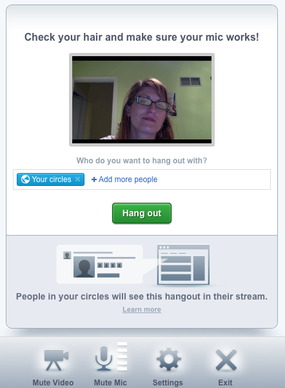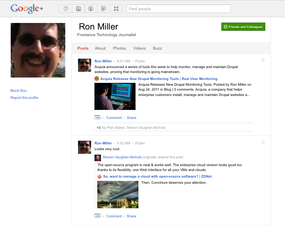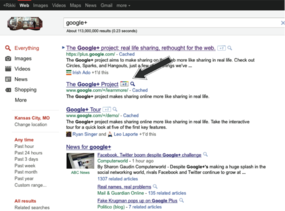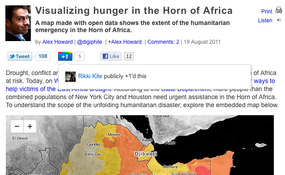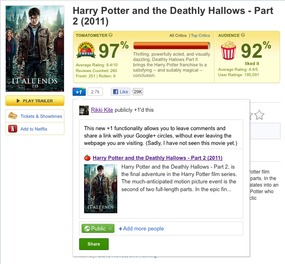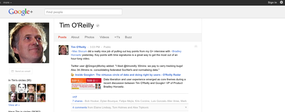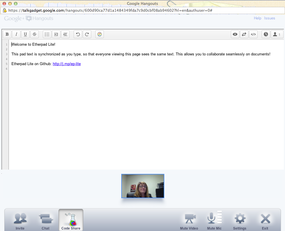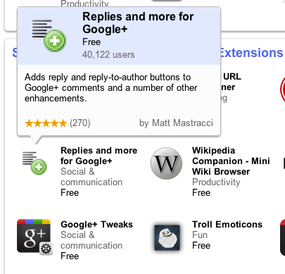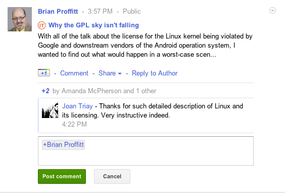Google+ Means Business
Google+ isn’t officially ready for corporate use, but users are already excited about what this new social networking platform means for the workplace. We look at how you can leverage Google’s latest product for business and work around its limitations.
When it was launched in June 2011, Google+ rolled out in beta-testing mode and, like the early days of Gmail, users needed an easy-to-obtain “invitation” to join. Within a few short weeks, Google+ users numbered in the millions – millions of beta testers providing valuable feedback to Google while also using older social media channels to recruit new Google+ users.
In an August webcast with O’Reilly Media founder Tim O’Reilly, Bradley Horowitz, Google Vice President of Product Management, explained the launch of the new social media network. In the interview, Horowitz says that Google+ use has been skewed toward the “techie elite,” but that it is also a very international product. He notes that Hangouts, a Google+ feature that allows users to connect on Google+ via webcams (Figure 1), have been hugely popular.
Despite paying for Google Apps services, enterprise users weren’t given immediate access to Google+. Horowitz says that Google did not want to frustrate that huge batch of users while the kinks were getting worked out of this young Google product. O’Reilly, who is also a Twitter user, says that, despite having approximately 55,800 followers on Google+ compared with more than 1,489,000 Twitter followers, he notices more comments and feedback on his Google+ blog posts.
Horowitz explains that Google+ is different. “It’s not just the engagement,” he says. “It’s the rate of engagement and the intensity of engagement.”
But, Horowitz also says developers are hearing feedback that Google+ engagement is too fast and people can’t keep up with their streams. Of Twitter, with its 140-character limitation, O’Reilly says, “There’s this wonderful stream going by and you can dip your bucket in it, but you don’t have to drink the water.”
So, how are early adopters of Google+, which is still in a limited field trial at the time of this writing, using the service in business environments?
Marketing Within Google+
As with other social networking tools, Google+ has huge marketing potential, and with the backing of Google, this new player might have an edge over the competition. “Do you really want to get people to pay attention to your products? I do; in my case, it’s stories,” says journalist Steven Vaughan-Nichols.
Vaughan-Nichols says that he promotes all of his articles on Google+. “Of course, I do that with other social networking services as well,” he says. “What makes Google+ better than the others is that I get real feedback from people who actually take the time to think about my message. Do you know how rare that is?”
“I use it in much the same way I use other online social networking tools,” says freelance technology writer Ron Miller. “I share content I like or find interesting, and I promote my own articles, as well.”
Miller says he’s not sure how much traffic Google+ drives to his links, but he thinks there could be indirect positive traffic results because of the Google+ connection to Google searches. “I’m fairly confident the search algorithm is paying attention to +1s and pushing up content that proves more popular,” he says (Figure 2).
The Power of +1
In March, Google launched the +1 button, which allows users to recommend content in Google search results and ads (Figure 3). Then, in early June, Google launched the +1 button for pages in websites (Figure 4).
In late August, Google announced that the +1 button would also allow users to leave comments and share web pages with selected circles in Google+ (Figure 5).
The potential of this expanded functionality means a business could organize information and send it to select audiences. For example, a restaurant owner could recommend an article about the new chef in the local paper to a circle of customers, suggest a recipe link to a circle of kitchen staff, send a link about a new city ordinance to a management circle, and so on (Figure 6).
Sharing from Google+
John Blossom, President of Shore Communications Inc., says that he uses Google+ to build an audience for his content and to build relationships with potential and existing clients. “Google+ builds on Buzz by providing a much easier way to share information with specific people in private with its Circles feature, but also enables easy public sharing of content and comments, both on Google+ itself and on the web,” Blossom says (Figure 7). “In this way, Google+ is notably different than Facebook, LinkedIn, and many other social media services, which typically require one to be logged in to see any content on their services, limiting or curtailing its ability to be discovered via search engines.”
Hangouts Are Huge
“Google+ also makes it possible to initiate group video and text chats with up to ten people, a feature that has been used extensively by Google to collect feedback from people using Google+, but is used increasingly for small-scale webinars and other more business-oriented services,” Blossom says.
Although Google+ Hangouts only allowed up to 10 participants at launch, users quickly found ways around this limitation by recording their video sessions and sharing them publicly. For example, some teachers are recording hangouts to use as webinars. Currently Google+ doesn’t have a built-in way to record hangouts, but free third-party tools are available.
On July 15, the Tibet Action Institute held a Hangout press conference, which they claim is the first global press conference on Google+. The conference was recorded with Ustream and is now available at the tibetnetwork.org site.
Businesses are already leveraging Google+ Hangouts for meetings and training. For example, you and several colleagues located from remote offices could use Google+ to meet online. Unlike IRC or Skype meetings, attendees have the advantage of seeing each other, watching video together, or viewing other training materials.
For example, a Hangout meeting attendee could show other attendees how to assemble a new company product or introduce a new office employee to the offsite staff. Or, a salesperson could meet in a Hangout with new clients to discuss product options, and an engineer could meet with customers who need tech support or training.
Enterprising Add-Ons
Although Google is currently mum on upcoming plans for Google+, users have already been busy extending the product’s functionality.
The Chrome extension Hangout Pad for Google+ already has more than 1,300 users. Google+ users who install this extension can click on the icon on the bottom of the Hangout screen (Figure 8) to open a shared window for collaborative coding (Figure 9).
In his webcast with Tim O’Reilly, Bradley Horowitz admitted that he uses the Replies add-on, which currently has more than 40,000 users, indicating that this feature is in demand even though it is not built in (Figures 10 and 11).
Beyond Beta
Beta testers are sending detailed feedback to Google about what’s missing or could be improved in Google+. According to John Blossom, “As of now, Google+ lacks features that can help people to separate business networking from personal networking with a high level of efficiency, and lacks the ‘go-to’ status for business use that a service like LinkedIn enjoys.” He says, “It would be very difficult using the current features of Google+ to launch a B2B marketing campaign, for example.”
Blossom says that despite controversy surrounding Google+ requirements for users to use “real” names instead of pseudonyms, he commends them for their intentions. “They are doing this in part to ensure that searches that reference content in Google+ are evaluating content from people who are not trying to game search algorithms with multiple false IDs or to hide behind a false ID to promote interests such as commercial products or politicians.”
Blossom says Google+ also needs more features to enable content discovery. “As of now, there is no search feature built in to Google+, although it is possible to find publicly posted content in Google+ via the main Google search feature,” he says. “Also, Google+ does not yet support any sort of content categorization or tagging schemes, though some early users of Google+ have adopted Twitter’s convention of hashtags (the # character followed by a keyword) as an informal method of identifying content relating to particular keyword topic; however, without search features built around such metadata, they are not very useful so far.”
Dan Keldsen, President of Information Architected Inc. uses Google+ to work in real time with distributed teams. “It’s not quite replacing Skype for video conferencing, or ‘pure’ Google Docs for live co-editing of agendas, proposals, and meeting notes, but it’s showing more immediate promise than Google Wave,” he says. “It is still difficult to work with larger companies while using Google+ due to the requirement of a Gmail account,” Keldsen adds.
Keldsen thinks that Google’s new social media product seems like a smarter Twitter because extended conversations are easier to follow. He says it’s a smarter blogging platform because of real time and a more “web native” ability to drop in multimedia, and because its not walled, like Facebook, it’s better for business collaboration. Keldsen says that Google seems much more serious about the Google+ launch than they were with Google Wave. “Still early days for Google+, but this is one of the least ‘beta’ offerings that Google has launched that I can recall,” he says.
Rikki Kite is Director of Marketing at Advanced Clustering Technologies in Kansas City, Kansas. In addition to Linux Magazine and Linux Pro Magazine, Kite has been published in Sys Admin Magazine and on UnixReview.com. She can be contacted at rkite@advancedclustering.com.
